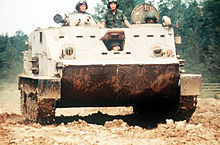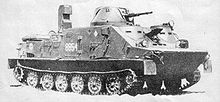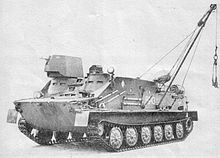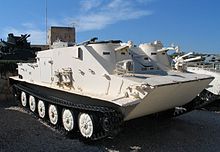- OT-62 TOPAS
-
OT-62 TOPAS 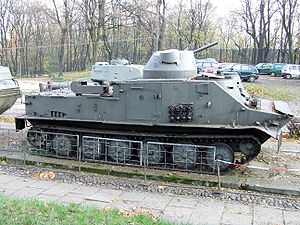
TOPAS-2AP in Polish Army Museum in Warsaw, 8 November 2006.Type Tracked Amphibious Armored Personnel Carrier Place of origin  Czechoslovakia
Czechoslovakia
 Poland
PolandService history In service 1962–present Used by See Operators Wars See Service History Production history Designed 1958–1962 Manufacturer Podpolianske Strojárne (PPS) plant Produced 1963–1972 Variants See Variants Specifications Weight 13 tonnes
15 tonnes with combat equipment[1]Length 7.1 m[1] Width 3,14 m[1] Height 2,1 m Crew 2 (driver and commander) (+16 passengers) Armor Welded, rolled steel
17 mm thickEngine PV-6 6-cylinder, in line diesel
300 hp (224 kW) at 1,800 rpmSuspension Torsion bar Ground clearance 410 mm Fuel capacity 407 l Operational
range450 km – 550 km (road)
150 km (water)Speed 60 km/h (road)[1]
10,8 km/h (water)The OT-62 TOPAS is a series of amphibious tracked armoured personnel carriers developed jointly by Poland and Czechoslovakia (ČSSR). OT-62 stands for Obrněný Transportér vzor 62 – "armoured personnel carrier model 62". TOPAS stands for Transportér Obrněný Pásový – "tracked armoured personnel carrier".
Contents
Development
In the late 1950s Czechoslovakia bought license to produce BTR-50s from the Soviet Union. The received documentation was used to develop a new tracked armoured personnel carrier for Czechoslovak army and Ludowe Wojsko Polskie (LWP). The works started in 1958 and first prototype was completed in 1962. After it passed the trials it was accepted and received a name TOPAS.
Because the standard TOPAS vehicle used by Ludowe Wojsko Polskie (LWP) (Polish People's Army) was unarmed, the design bureau of Wojskowa Akademia Techniczna (WAT) (Military Technical Academy) designed a variant armed with a new turret placed centrally on top of the superstructure. Also another TOPAS variant was designed by Wojskowy Instytut Techniki Pancernej i Samochodowej (Military Institute of Armour and Car Technology). The new variant received designation WPT-TOPAS and was a technical support vehicle.
Description
Like the BTR-50PK, the OT-62 TOPAS has a flat, boat-shaped hull and has a superstructure in the front of the vehicle. The hull of the OT-62 TOPAS is made of all-welded rolled steel with the crew compartment at the front, troop compartment in the center and the engine compartment at the rear. It has an ability to transport up to sixteen fully equipped infantrymen who sit on benches which run across the full width of the troop compartment. Their primary way of mounting and dismounting the APC by climbing over the sides of the hull and going through two rectangular roof hatches however OT-62 TOPAS has side hatches in the sides of the superstructure making for a good alternative to the rectangular roof hatches thus it doesn't have the protection issue of BTR-50 APC in which the passengers didn't have any kind of alternative route in and out. Driver sits in the center of the front of the hull and has three vision blocks and periscopes located at the top of the sloping glacis plate. During night operations the center periscope is switched for the TVN-28 night vision device which gave the driver a clear vision up to 60 meters. The driver also has a small hatch that opens upwards and while it can't be used for the driver to leave the vehicle, it can be opened by the driver in relatively safe areas for extra vision. When in combat the hatch is closed and the driver can use a vision block for a limited vision. Under the driver's seat there is an emergency hatch which can be used by all crew members. The commander who sits on the left hand side of the front of the vehicle has three vision blocks and periscopes in a projecting bay and a copula with vision block on its basis facing forward. It is located on top of projecting bay, opens forwards and can be locked vertically. It also has two projecting bays like the BTR-50PU command vehicle instead of one in BTR-50 APCs. However the bays are different from one another when it comes to shape. The second projecting bay also has three vision blocks and periscopes. On top of the second projecting bay is a copula which replaces the additional rectangular roof hatch from BTR-50PK.[1][2]
The torsion bar suspension consists of six evenly spaced large rubber-tired road wheels with the drive sprocket at the rear and the idler at the front. Road wheels are hollow to ensure additional amphibious abilities. Usage of hollow road wheels increased APC's buoyancy by 30%. There are no track-return rollers. The first and last road wheels have a hydraulic shock absorber and the steel tracks with a single pin have 96 chain links each when new. There is a small, thin, horizontal skirt over each track. OT-62 has the PV-6 6-cylinder, in line diesel engine developing 300 hp (224 kW) at 1,800 rpm. The engine gives it a road speed of 60 km/h with a cruising range of 450 km – 550 km. The vehicle can cross 0.9 m high vertical obstacles and 2.8 m wide trenches and climb 38° gradients.[1]
OT-62 TOPAS is amphibious thanks to its flat, boat-shaped hull which is hermetical and ensures minimal resistance when APC is afloat and can swim after switching on the two electric bilge pumps, erecting the trim vane which improves the stability and displacement of the vehicle in water and prevents the water from flooding the bow of the APC and switching the driver's periscope for a swimming periscope that enables the driver to see over the trim vane. There is also a manual bilge pump for emergency use. The bilge pumps keep the APC afloat even if it is hit, damaged or leaks. In water it is propelled by two hydrojets, one in each side of the hull, with the entrance under the hull and exits at the rear of the hull. There are also additional assistant water-jet entrances in both sides of the hull over the last road wheels. The rear exits have lids that can be fully or partially closed, redirecting the water stream to the forward-directed exits at the sides of the hull, thus enabling the vehicle to turn or float reverse, for example to go left the left water-jet is covered, to go the right the right water-jet is covered and to make a 180° turn the left water-jet sucks in water and the right water-jet pushes it out. This system was designed by N. Konowalow. It is the same system as the one used in PT-76 amphibious light tank. The vehicle has a low freeboard of 15 cm to 20 cm however it can compensate for it by using the snorkel the mount for which is located on the right hand side of the front of the engine deck.
The vehicle is equipped with an IR driving light and an IR searchlight. The vehicle also has a stowage bucket placed centrally in the front of the engine deck. The IR searchlight was removed from the right hand side of the front of the superstructure as the area there was used for the second projecting bay. It was instead fitted on the commander's copula. It also has two mounts for shovels on either side of the front of the vehicle as well as two mounts for pickaxes on left hand side of the superstructure.
Service history
OT-62 TOPAS entered production and service with Czechoslovak army in 1963 and shortly after it also entered service with Ludowe Wojsko Polskie (LWP) in early 1960s. As an amphibious vehicle based on PT-76 which was already in use, the TOPAS APC along with improved TOPAS-2AP was used by the Coast Defense units including the 7th Lusatian Landing Division (officially known as 7th Coast Defense Division). It was also exported to yet another Warsaw pact member, Bulgaria and several other countries around the world including Angola, Egypt, India, Iran, Iraq, Libya, Morocco, Sudan and Syria.
Along BTR-50, the OT-62 TOPAS were used by Egypt and Syria in the Six-Day War (1967). Some vehicles were captured and commissioned by the Israel Defense Forces. Both sides used BTR-50 and OT-62 TOPAS APCs during War of Attrition (1968–1970). During the Yom Kippur War (1973) the BTR-50 and OT-62 TOPAS APCs were also employed by both sides. Some of the Israeli BTR-50 and OT-62 TOPAS were later transferred to the South Lebanon Army.
OT-62 TOPAS also saw service with Iraqi army during First Persian Gulf War and 2003 Invasion of Iraq.
Variants
former Czechoslovakia
- OT-62 (OT-62 stands for Obrněný Transportér vzor 62 – "Armoured Personnel Carrier model 62") – series of BTR-50 copies developed jointly by Poland and Czechoslovakia. They are similar to BTR-50PK but have side hatches in the hull sides, stronger PV-6 engine with power of 300 hp (224 kW) and with two projecting bays like the BTR-50PU.
- OT-62A (OT-62 stands for Obrněný Transportér vzor 62 – "Armoured Personnel Carrier model 62") (1962) – Basic APC variant. The model used by the Ludowe Wojsko Polskie is called TOPAS (See Poland section for details).[2]
- OT-62B (OT-62 stands for Obrněný Transportér vzor 62 – "Armoured Personnel Carrier model 62") – APC variant fitted with a small turret on top of the second projecting bay replacing the cupola that was there. It is armed with the 7.62 mm Vz. 59T general purpose machine gun and the 82 mm T-21 "Tarasnice" recoilless gun on an external mount. The rate of fire of the 82 mm T-21 "Tarasnice" recoilless gun depends on how fast can the loader can reload it. To reload the recoilless gun the loader must exit the vehicle first exposing himself to enemy fire. The vehicle carriers from 5 to 10 rounds for the 82 mm T-21 "Tarasnice" recoilless gun. The model used by the Ludowe Wojsko Polskie is called TOPAS-2A (See Poland section for details).[1][2]
- OT-62 R-2 R-105 – OT-62B converted into a signals and command vehicle with additional radios. The vehicle retains its small mg turret on top of the second projecting bay however it doesn't have the 82 mm T-21 "Tarasnice" recoilless gun on an external mount. The vehicle has four additional radios R-113, R-112, R-105U and R-105d. It also has a generator and a stowage box on the left hand side of the engine deck.Photos[2]
- OT-62 R-2 R-108 – OT-62B converted into a signals and command vehicle with additional radios. The vehicle retains its small mg turret on top of the second projecting bay however it doesn't have the 82 mm T-21 "Tarasnice" recoilless gun on an external mount. It also has a generator and a stowage box on the left hand side of the engine deck.[2]
- OT-62 R-2M – OT-62B converted into a signals and command vehicle with additional radios. The model used by the Ludowe Wojsko Polskie is called TOPAS R-2M (See Poland section for details).[2]
- OT-62D (OT-62 stands for Obrněný Transportér vzor 62 – "Armoured Personnel Carrier model 62") – OT-62 carrying the 82 mm Bzk vzor 59 recoilless gun on the rear deck. It also retains original armament in turret (T-21 RR and UK vz. 59 MG).
- OT-62A converted into an armoured ambulance.[2]
- OT-62B (OT-62 stands for Obrněný Transportér vzor 62 – "Armoured Personnel Carrier model 62") – APC variant fitted with a small turret on top of the second projecting bay replacing the cupola that was there. It is armed with the 7.62 mm Vz. 59T general purpose machine gun and the 82 mm T-21 "Tarasnice" recoilless gun on an external mount. The rate of fire of the 82 mm T-21 "Tarasnice" recoilless gun depends on how fast can the loader can reload it. To reload the recoilless gun the loader must exit the vehicle first exposing himself to enemy fire. The vehicle carriers from 5 to 10 rounds for the 82 mm T-21 "Tarasnice" recoilless gun. The model used by the Ludowe Wojsko Polskie is called TOPAS-2A (See Poland section for details).[1][2]
- DTP-62 (DTP-62 stands for Dílna Technické Pomoci – 62) – OT-62 converted into an technical support vehicle.[2]
- OT-62 R-3MT – OT-62A converted into a signals and command vehicle with additional radios. It has a generator and two stowage boxes on the engine deck. It also has a collapsible radio mast as well as two dome shaped ventilators on top of the superstructure. Also the copula on to of the second projecting bay was moved to the center of the fron of the roof of the superstructure.Photos[2]
- OT-62 R-4MT – OT-62A converted into a signals and command vehicle with additional radios. It has a generator and two stowage boxes on the engine deck. Also the hatch in the right hand side of the superstructure has been removed.[2]
- OT-62A (OT-62 stands for Obrněný Transportér vzor 62 – "Armoured Personnel Carrier model 62") (1962) – Basic APC variant. The model used by the Ludowe Wojsko Polskie is called TOPAS (See Poland section for details).[2]
Poland
- TOPAS (transporter obrneny pasovy) – Basic APC variant. Some were fitted with a locater light between the two copulas on top of two projecting bays (these were most probably used by Coast Defense units). The model used by CSLA is called OT-62A (See Czechoslovakia section for details).
- TOPAS-2A – APC variant fitted with a small turret on top of the second projecting bay armed with a 7.62 mm vz.59T general purpose machine gun and an 82 mm T-21 "Tarasnice" recoilless gun on an external mount. The rate of fire of the 82 mm T-21 "Tarasnice" recoilless gun depends on how fast can the loader reload it. To reload the recoilless gun the loader must exit the vehicle first exposing himself to enemy fire. The vehicle carriers from 5 to 10 rounds for the 82 mm T-21 "Tarasnice" recoilless gun. The model used by CSLA is called OT-62B (See Czechoslovakia section for details).[1]
- TOPAS R-2M – TOPAS-2A converted into a signals and command vehicle. The model used by CSLA is called OT-62 R-2M (See Czechoslovakia section for details).
- TOPAS-2AP – Polish upgrade with a WAT turret placed centrally on the superstructure. It is armed with 14.5 mm KPVT heavy machine gun and 7.62 mm SGMT coaxial medium machine gun. The same turret can be found on the SKOT-2AP. Later the 7.62 mm SGMT medium machine gun was replaced by the 7.62 mm PKT general purpose machine gun. Because of the turret the top rectangular roof hatches were moved to the sides of the top of the superstructure. The turret was operated by a gunner which therefore increased the number of crew members from two to three. Because the turret is taking some space from the troop compartment, the number of fully equipped soldiers transported has decreased from sixteen to twelve. Because of the addition of the turret the weight of the vehicle has increased to 15.1 tonnes and 16 tonnes when it's loaded with combat equipment.
- TOPAS-2AP variant used by mortar crews. It has been modified so it now can transport up to two 82 mm mortars and 8 mortar crew members. The 82 mm mortar has a rate of fire of 25 rounds per minute. The vehicle carriers from 50 to 100 mortar rounds.[1]
- WPT-TOPAS (WPT stands for Wóz Pogotowia Technicznego – "Technical Support Vehicle") – TOPAS converted into a technical support vehicle which was intended to evacuate damaged TOPAS APCs and PT-76 amphibious light tanks from the battlefield, especially the ones trapped by water obstacles with their amphibious ability broken. It was also intended to repair these vehicles in field conditions and bring medical help to the wounded crew members. Its equipment included winch with a maximum capacity of 2.5 tonnes and 600 m cable which was used to pull out the vehicles trapped on the water, a manual crane with a maximum capacity of 1 tonne and capability to be fitted in different parts of the vehicle, stowage boxes with tools, devices and equipment used to repair damaged vehicles in field conditions, welding set, pontoon and equipment for divers. The vehicle is armed with a single PK general purpose machine gun mounted on right hand side cupola with large v-shaped shield around it.[2]
- TOPAS R-3M – TOPAS converted into a signals and command vehicle with additional radios.
- TOPAS-2A – APC variant fitted with a small turret on top of the second projecting bay armed with a 7.62 mm vz.59T general purpose machine gun and an 82 mm T-21 "Tarasnice" recoilless gun on an external mount. The rate of fire of the 82 mm T-21 "Tarasnice" recoilless gun depends on how fast can the loader reload it. To reload the recoilless gun the loader must exit the vehicle first exposing himself to enemy fire. The vehicle carriers from 5 to 10 rounds for the 82 mm T-21 "Tarasnice" recoilless gun. The model used by CSLA is called OT-62B (See Czechoslovakia section for details).[1]
India
- FRT TOPAS (FRT stands for Forward Repair Time vehicle) – TOPAS-2A converted into a Technical support vehicle.
Iraq
- OT-62A fitted with the slab-sided turret from the Brazilian EE-9 Cascavel armoured car. It was intended to be used for fire support.[2]
Israel
- OT-62A TOPAS fitted with two machine gun mounts, each in front of a hatch on top of both copulas.
Operators
 Algeria – 30 OT-62 TOPAS and BTR-50.[3]
Algeria – 30 OT-62 TOPAS and BTR-50.[3] Angola –
Angola – Bulgaria –
Bulgaria – Egypt – 500 OT-62 TOPAS (including OT-62B).[2]
Egypt – 500 OT-62 TOPAS (including OT-62B).[2] India – TOPAS, TOPAS-2A and FRT TOPAS.[2]
India – TOPAS, TOPAS-2A and FRT TOPAS.[2] Iran – 150 OT-62 TOPAS (including OT-62B) and BTR-50[2][4]
Iran – 150 OT-62 TOPAS (including OT-62B) and BTR-50[2][4] Libya – 700 OT-62 TOPAS, BTR-50 and BTR-60 as of 1986.[5] 540 OT-62 TOPAS, BTR-50 and BTR-60 as of right now.[6]
Libya – 700 OT-62 TOPAS, BTR-50 and BTR-60 as of 1986.[5] 540 OT-62 TOPAS, BTR-50 and BTR-60 as of right now.[6] Morocco –
Morocco – Slovakia –
Slovakia – Sudan –
Sudan – Syria – 1,000 OT-62 TOPAS, BTR-50, BTR-60 and BTR-70 APCs.
Syria – 1,000 OT-62 TOPAS, BTR-50, BTR-60 and BTR-70 APCs.
Former Operators
 Czechoslovakia – Passed on to successor states.
Czechoslovakia – Passed on to successor states. Iraq – All destroyed or scrapped.
Iraq – All destroyed or scrapped. Israel – Captured a number of OT-62 TOPAS and BTR-50 APCs from Egypt and/or Syria during Six-Day War. Withdrawn from service in 2002.[7]
Israel – Captured a number of OT-62 TOPAS and BTR-50 APCs from Egypt and/or Syria during Six-Day War. Withdrawn from service in 2002.[7] Poland – 200, all were withdrawn from service in 1994. They were given to the museums, sold to other countries or used for target practice on proving grounds.
Poland – 200, all were withdrawn from service in 1994. They were given to the museums, sold to other countries or used for target practice on proving grounds. South Lebanon Army –
South Lebanon Army –
References
External links
Main battle tanks Light tanks Infantry fighting vehicles Armoured personnel carriers Armored cars MRAPs Cougar HFour-wheel drive vehicles Self-propelled guns Rocket artillery Self-propelled anti-aircraft guns Self-propelled surface-to-air missile systems Tatra models Cars Civilian trucks: NW First Truck · 13 · 22 · 23 · 24 · 25 · 26 · 27 · 27B · 28 · 43 · 49 · 50 · 51 · 72 · 74 · 79 · 81 · 84 · 85 · 85A · 86 · 92 · 111 · 114 · 115 · 116 · 128 · 130 · 138 · 141 · 147 · 148 · 157 · 158 Phoenix · 163 Jamal · 400 · 401 · 500 · 700 · 805 · 810 · 813 · 815 · 815-2 · 816 · BetaMilitary trucks: Prototypes and racing cars: NW Rennzweier · 12 Targa Florio · 30 Sport · 90 · 137 · 201 · 600 Diesel · 601 Convertible · 601 Monte Carlo · 602 Tatraplan Sports · 603A · 603 B5 · 603 B6 · 603 MB · 603 Monte Carlo · 603 X · 604 · 605 · 607 · 607-2 · 625 · Baghira · Dolphin · JK 2500 · microbus · MTX V8 · Prezident · V570 · V855 · Jamal EvoCategories:- Command vehicles
- Armoured personnel carriers of the Cold War
- Weapons of Czechoslovakia
- Armoured personnel carriers of Poland
- Czechoslovakia–Soviet Union relations
- Amphibious armoured personnel carriers
- Czechoslovakia–Poland relations
- OT-62 (OT-62 stands for Obrněný Transportér vzor 62 – "Armoured Personnel Carrier model 62") – series of BTR-50 copies developed jointly by Poland and Czechoslovakia. They are similar to BTR-50PK but have side hatches in the hull sides, stronger PV-6 engine with power of 300 hp (224 kW) and with two projecting bays like the BTR-50PU.
Wikimedia Foundation. 2010.

